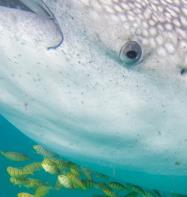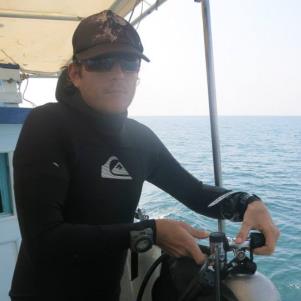-

Marine life of La Paz - Whale Sharks
Swimming with whale sharks is easy here in La Paz. Find out more.
La Paz is home to whale sharks from September to March, with the season sometimes extending longer depending on the ocean temperatures. La Paz is most commonly accessed through Cabo San Lucas, there are international flights from most cities in the USA and Canada to Cabo San Lucas and than it's a two hour drive to get to La Paz. La Paz has hotels and restaurants to suit everyone's budget and there are many other places to explore by car and boat. If you are a scuba diver there are plenty of different dive sites to occupy even the most seasoned diver.
Whale shark trips can be booked through local companies, private charter boats and independantly through captains who sell their tours on the streets of La Paz. To insure that your service provider has the appropriate permits and training look for the whale shark flag, which should be displayed on the boat.
Swimming with whale sharks here is a unique experience and much different than other locations around the globe. The whale sharks are here for one reason, to feed. When they are feeding they are swimming very slowly and close to the surface presenting the ideal opportunity to swim with them up close an personal. However this is a double-edged sword as it is very easy for people to disturb these feeding cycles by getting too close, using flash photography or by tourist providers not observing the guidelines.
Here are some tips for observing the whale shark that will benefit both you and the whale shark.
Like most fish, whale sharks sense their surroundings using an organ called the lateral line. These lines run horizontally down the body of the whale shark and detect movement in the water through vibrations. If the whale shark is detecting a lot of vibrations they may react by diving down deeper to escape the potential threat. This disturbs the whale shark's feeding pattern and is not going to result in a good viewing. When you enter the water try not to make a splash, when swimming with the whale shark use your fins only, do not swim with your arms or jerky movements. The idea is to swim parallel with the whale shark ensuring that you do not get in front of it and causing it to change it's direction.
When going with a tourist provider ensure that they observe the rules of whale shark viewing, typically the rules are bent to please the guests so speak out if you think they are doing something improper. Whale shark viewing guidelines are different in each area so familiarize yourelf with the rules before going on a trip.
We here at Baja Connections hope you get the chance to swim with these magnificent creatures and that through observing the guidelines we have minimal impact on the whale sharks during the time that they spend here.



Load more comments